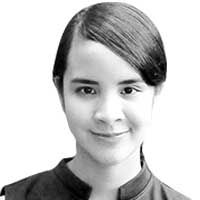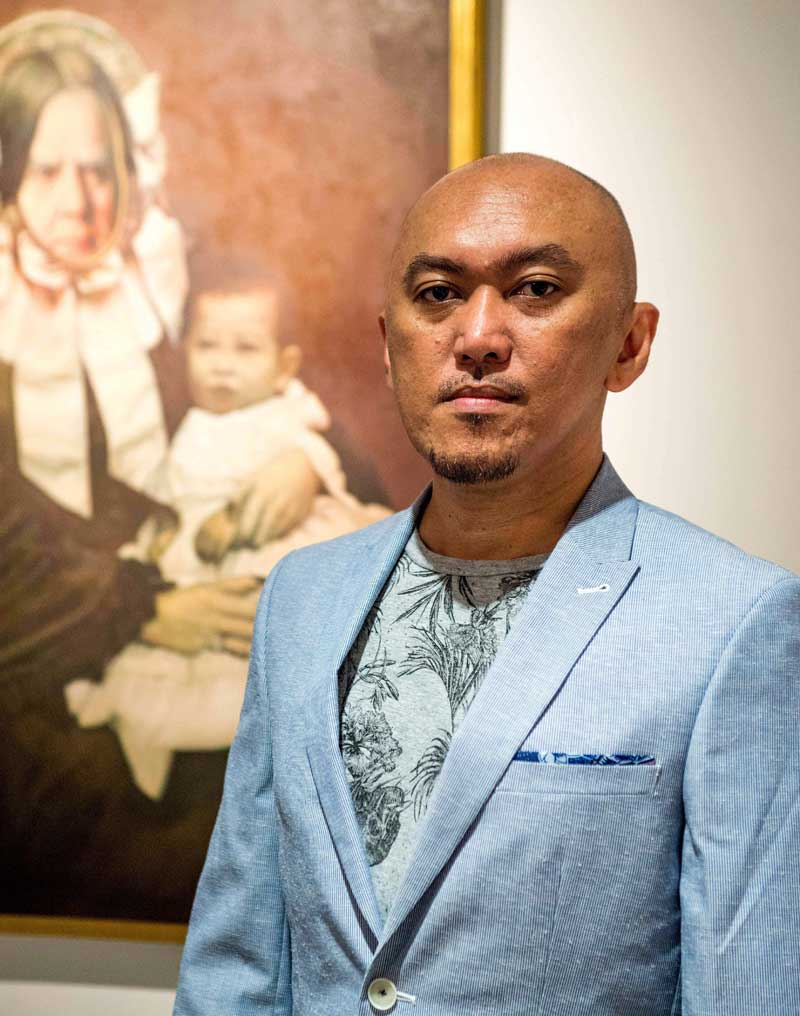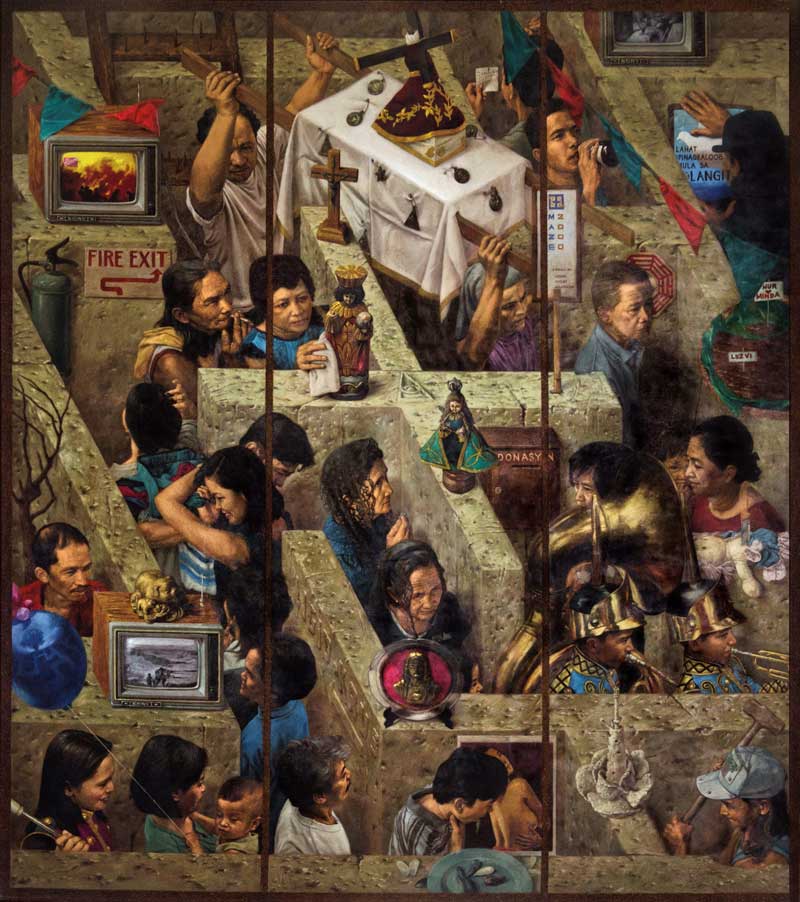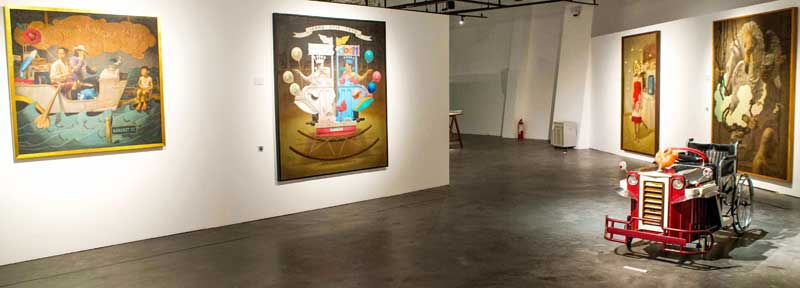The masked prophets march on


25 years of Alfredo Esquillo
From an outsider’s perspective, Alfredo Esquillo Jr.’s painted mob looks like a circus waiting for a god to arrive.
And for a brief moment while walking across the three expansive spaces of his retrospective, “Continuing Spirit: Alfredo Esquillo,” I felt like a pilgrim among his painted pilgrims, looking for a holy thing to manifest amid the riot.
The exhibition, on view until Jan. 20 at the Ateneo Art Gallery, Arete, celebrates Esquillo’s 25 years in the art world. It coincides with the launch of his self-titled book, published by Eskinita Art Gallery, featuring biographical essays by Jay Giovanni Bautista, and showing how the noted critics of our time regarded his extraordinary talent. Of his first solo exhibition at Hiraya Gallery, the late Alice Guillermo writes, “Pictorial realism has reached a new watermark of achievement in the works of Alfredo D. Esquillo Jr… In this age of computer technology, one scrutinizes his paintings for the use of scanning or photo-transfer devices only to be assured that they were all painstakingly delineated by the artist’s own hand.”

“The show as a whole shows an overarching context about loob and its permutations in Filipino culture, while also showing my different transitions and tendencies in my art practice,” explains Esquillo.
His mastery of figurative realism, rendering details with consummate skill and resulting in figures that seem to pop out of the painting frame, is lauded among his peers and critics. But of his chosen subject matter, it is Patrick Flores who puts it perfectly: “He is interested in things that matter to people who live and die in this country.”
Esquillo has always sought to flesh out aspects of the Filipino identity: its shapes and its creases, its dark brown heat, its faces strained in between states of unease and religious euphoria, its yellow, glowing unrest. The artist belonged to a devout family “who kept changing religions, from Catholic to Charismatic,” and in 1994, he began documenting Quiapo — the microcosm of the Filipino psyche, according to Renato Habulan, his longtime mentor, collaborator, and now curator of his exhibition. Although the gallery’s three dividing sections intend to delineate the chronological turns and tendencies in his artistic career, the exhibition also creates a path that seemingly winds back and turns inward. According to Esquillo, the show “begins with loob (and) ends with loob.”

“Daang Ligid Krus” (1996) is Esquillo’s early award-winning work, illustrating the artist’s interest in folk religion, survival, and salvation. Image courtesy of the artist
“Loob” invites a world of implications: faith, will, character, everything that isn’t seen but only manifested through things that are. And what is seen in Esquillo? Coiling within the narrow, constricting labyrinth of “Daang Ligid-Krus” (1996), his Philip Morris prize-winning work, is a serpentine line of worshippers, revelers, and entertainers, painted in an atmosphere of yellow-browns. Hardly pious but a touch absurd, many of these religious processions abound in the first room, reminding me of elaborate parades and their penchant for theatricality and the carnivalesque. As we, the viewers, march on with his bands, the sense of irony and play continues in the next room where we find his iconic “MaMcKinley” put together with “The Colonizer.”
“These two works,” says Esquillo, “lead to a split-series — one tackling history via the use and tampering of vintage photographs and one integrating fine arts with crafts (banig, weaving).” A lot has already been written about the works in this section and their wealth of historical references, but what I find most fascinating and unsettling is simply how they tamper with the human face. Somewhere in that woven surface, in that amalgam of teeth, tongue and warped lip, “The Colonizer” bares the beaming smile of one Ronald McDonald. In a Victorian mother-and-child portrait, the face of the mother (“MaMcKinley”) is traded for the stern, uncanny window cut-out of William McKinley. In paintings of school children and of a wedding ceremony, there are coins and black voids where faces should be. I’m reminded of nightmare-worlds where the horror begins in seeing a face, disfigured. Esquillo, however, doesn’t give us faces but masks, as though alluding, as Flores notes, to the deceit of history and the image.
In his more recent paintings, the artist implicates himself in compositions that deal with religious iconography.
While Esquillo is preoccupied with the loob, his works never fail to pull me back to the outside, to a fierce obsession with appearance and the sheen of the surface. His tragicomedy series appears in the third room and there is something powerfully ironic in how these objects are painted. Consider his seas and clouds: we gaze at the blues of the waves only to be struck by an edge or a sharp cut, betraying their two-dimensionality. Here, clouds are not immense bodies of smoke but kitschy decors in carnival rides —breakable wood, artificial perfume. It is as though the realist, after heavily working the surface, points to its artificiality and flatness. These carnival clouds resemble colorful stage pieces, all heavy illusions, all waiting to be disassembled and struck down when the play is done.
In bringing these works together, the retrospective traces recurring themes and invites new narratives in Esquillo’s remarkable body of work. His later paintings, still dense with symbolism yet spare in their style, implicate the artist himself in various dispositions, cracking open a highly subjective space. After the masquerade, when the crowds have dispersed and all paint chipped away, what we find isn’t god, but the artist in forms of display. Esquillo ponders, “My concepts about loob extend to universal views about spirituality. I’m interested in ideas about how we are all connected to others, how loob leads to Sangkalooban.”

The third section of the retrospective features Esquillo’s tragicomedy series, wherein he “pushed the idea of composing elements like in a theater, and of using satire as an approach to tackling themes.”
* * *
“Continuing Spirit: Alfredo Esquillo” runs until Jan. 20 at the 3/F Ateneo Art Gallery, Arts Wing, Areté.



















